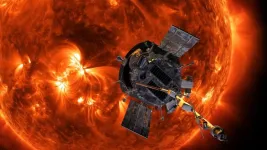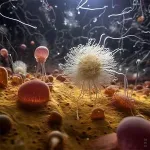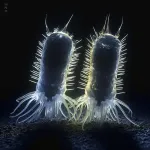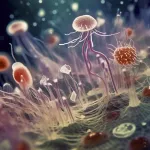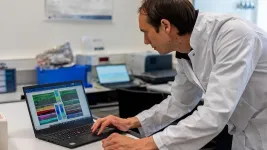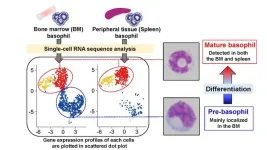(Press-News.org) NASA's Parker Solar Probe (PSP) has flown close enough to the sun to detect the fine structure of the solar wind close to where it is generated at the sun's surface, revealing details that are lost as the wind exits the corona as a uniform blast of charged particles.
It's like seeing jets of water emanating from a showerhead through the blast of water hitting you in the face.
In a paper to be published this week in the journal Nature, a team of scientists led by Stuart D. Bale, a professor of physics at the University of California, Berkeley, and James Drake of the University of Maryland-College Park, report that PSP has detected streams of high-energy particles that match the supergranulation flows within coronal holes, which suggests that these are the regions where the so-called "fast" solar wind originates.
Coronal holes are areas where magnetic field lines emerge from the surface without looping back inward, thus forming open field lines that expand outward and fill most of space around the sun. These holes are usually at the poles during the sun's quiet periods, so the fast solar wind they generate doesn't hit Earth. But when the sun becomes active every 11 years as its magnetic field flips, these holes appear all over the surface, generating bursts of solar wind aimed directly at Earth.
Understanding how and where the solar wind originates will help predict solar storms that, while producing beautiful auroras on Earth, can also wreak havoc with satellites and the electrical grid.
“Winds carry lots of information from the sun to Earth, so understanding the mechanism behind the sun’s wind is important for practical reasons on Earth,” Drake said. “That’s going to affect our ability to understand how the sun releases energy and drives geomagnetic storms, which are a threat to our communication networks.”
Based on the team's analysis, the coronal holes are like showerheads, with roughly evenly spaced jets emerging from bright spots where magnetic field lines funnel into and out of the surface of the sun. The scientists argue that when oppositely directed magnetic fields pass one another in these funnels, which can be 18,000 miles across, the fields often break and reconnect, slinging charged particles out of the sun.
"The photosphere is covered by convection cells, like in a boiling pot of water, and the larger scale convection flow is called supergranulation," Bale said. "Where these supergranulation cells meet and go downward, they drag the magnetic field in their path into this downward kind of funnel. The magnetic field becomes very intensified there because it's just jammed. It's kind of a scoop of magnetic field going down into a drain. And the spatial separation of those little drains, those funnels, is what we're seeing now with solar probe data."
Based on the presence of some extremely high-energy particles that PSP has detected — particles traveling 10 to 100 times faster than the solar wind average — the researchers conclude that the wind could only be made by this process, which is called magnetic reconnection. The PSP was launched in 2018 primarily to resolve two conflicting explanations for the origin of the high-energy particles that comprise the solar wind: magnetic reconnection or acceleration by plasma or Alfvén waves.
"The big conclusion is that it's magnetic reconnection within these funnel structures that's providing the energy source of the fast solar wind," Bale said. "It doesn't just come from everywhere in a coronal hole, it's substructured within coronal holes to these supergranulation cells. It comes from these little bundles of magnetic energy that are associated with the convection flows. Our results, we think, are strong evidence that it's reconnection that's doing that."
The funnel structures likely correspond to the bright jetlets that can be seen from Earth within coronal holes, as reported recently by Nour Raouafi, a co-author of the study and the Parker Solar Probe project scientist at the Applied Physics Laboratory at Johns Hopkins University. APL designed, built, manages and operates the spacecraft.
Plunging into the sun
By the time the solar wind reaches Earth, 93 million miles from the sun, it has evolved into a homogeneous, turbulent flow of roiling magnetic fields intertwined with charged particles that interact with Earth's own magnetic field and dump electrical energy into the upper atmosphere. This excites atoms, producing colorful auroras at the poles, but has effects that trickle down into Earth's atmosphere. Predicting the most intense winds, called solar storms, and their near-Earth consequences is one mission of NASA's Living With a Star program, which funded PSP.
The probe was designed to determine what this turbulent wind looks like where it's generated near the sun's surface, or photosphere, and how the wind's charged particles — protons, electrons and heavier ions, primarily helium nuclei — are accelerated to escape the sun's gravity.
To do this, PSP had to get closer than 25 to 30 solar radii, that is, closer than about 13 million miles.
"Once you get below that altitude, 25 or 30 solar radii or so, there's a lot less evolution of the solar wind, and it's more structured — you see more of the imprints of what was on the sun," Bale said.
In 2021, PSP's instruments recorded magnetic field switchbacks in the Alfvén waves that seemed to be associated with the regions where the solar wind is generated. By the time the probe reached about 12 solar radii from the surface of the sun — 5.2 million miles — the data were clear that the probe was passing through jets of material, rather than mere turbulence. Bale, Drake and their colleagues traced these jets back to the supergranulation cells in the photosphere, where magnetic fields bunch up and funnel into the sun.
But were the charged particles being accelerated in these funnels by magnetic reconnection, which would slingshot particles outward, or by waves of hot plasma — ionized particles and magnetic field — streaming out of the sun, as if they're surfing a wave?
The fact that PSP detected extremely high-energy particles in these jets — tens to hundreds of kiloelectron volts (keV), versus a few keV for most solar wind particles — told Bale that it has to be magnetic reconnection that accelerates the particles and generates the Alfvén waves, which likely give the particles an extra boost.
"Our interpretation is that these jets of reconnection outflow excite Alfvén waves as they propagate out," Bale said. "That's an observation that's well known from Earth's magnetotail, as well, where you have similar kind of processes. I don't understand how wave damping can produce these hot particles up to hundreds of keV, whereas it comes naturally out of the reconnection process. And we see it in our simulations, too. "
The PSP won't be able to get any closer to the sun than about 8.8 solar radii above the surface — about 4 million miles — without frying its instruments. Bale expects to solidify the team's conclusions with data from that altitude, though the sun is now entering solar maximum, when activity becomes much more chaotic and may obscure the processes the scientists are trying to view.
"There was some consternation at the beginning of the solar probe mission that we're going to launch this thing right into the quietest, most dull part of the solar cycle," Bale said. "But I think without that, we would never have understood this. It would have been just too messy. I think we're lucky that we launched it in the solar minimum."
END
Parker Solar Probe flies into the fast solar wind and finds its source
NASA probe got close enough to sun's surface to see hidden granular features
2023-06-07
ELSE PRESS RELEASES FROM THIS DATE:
Use of wearable devices in individuals with or at risk for cardiovascular disease
2023-06-07
About The Study: Among individuals with or at risk for cardiovascular disease, fewer than 1 in 4 use wearable devices, with only half of those reporting consistent daily use, according to the results of this study based on a nationally representative sample of U.S. adults in 2019 and 2020. As wearable devices emerge as tools that can improve cardiovascular health, the current use patterns could exacerbate disparities unless there are strategies to ensure equitable adoption.
Authors: Rohan Khera, M.D., M.S., of the Yale School of Medicine in New Haven, Connecticut, is the corresponding author.
To ...
What does ChatGPT say when you tell it you were sexually assaulted, you’re suicidal, or want to quit smoking?
2023-06-07
La Jolla, Calif. (June 5, 2023) — What does ChatGPT say when you tell it you were sexually assaulted, want to commit suicide, or are trying to quit smoking?
A new study published in JAMA Network Open led by John W. Ayers, Ph.D., from the Qualcomm Institute within the University of California San Diego, provides an early look into how artificially intelligent (AI) assistants could help answer public health questions.
Already, hundreds of millions use AI assistants like ChatGPT, and it will change the way the public accesses information. Given the growth of AI assistant use, the scientific team evaluated ...
Scientists discover ‘lost world’ of early ancestors in billion-year-old rocks
2023-06-07
The discovery of a “lost world” of ancient organisms that lived in Earth’s waterways at least 1.6 billion years ago could change our understanding of our earliest ancestors.
Known as the ‘Protosterol Biota’, these microscopic creatures are part of a family of organisms called eukaryotes. Eukaryotes have a complex cell structure that includes mitochondria, known as the “powerhouse” of the cell, and a nucleus that acts as the “control and information centre”. ...
Remains of an extinct world of organisms discovered
2023-06-07
Newly discovered biomarker signatures point to a whole range of previously unknown organisms that dominated complex life on Earth about a billion years ago. They differed from complex eukaryotic life as we know it, such as animals, plants and algae in their cell structure and likely metabolism, which was adapted to a world that had far less oxygen in the atmosphere than today. An international team of researchers, including GFZ geochemist Christian Hallmann, now reports on this breakthrough for the field of evolutionary geobiology in the journal Nature.
The previously unknown “protosteroids” were ...
Scientists discover ‘lost world’ of our early ancestors in billion-year-old rocks
2023-06-07
The newly discovered record of so-called protosteroids was shown to be surprisingly abundant throughout Earth´s Middle Ages. The primordial molecules were produced at an earlier stage of eukaryotic complexity – extending the current record of fossil steroids beyond 800 and up to 1600 million years ago. Eukaryotes is the term for a kingdom of life including all animals, plants and algae and set apart from bacteria by having a complex cell structure that includes a nucleus, as well as a more complex molecular machinery. “The highlight of ...
ChatGPT designs its first robot with TU Delft researchers
2023-06-07
Poems, essays and even books – is there anything the open AI platform ChatGPT can’t handle? These new AI developments have inspired researchers at TU Delft and the Swiss technical university EPFL to dig a little deeper: For instance, can ChatGPT also design a robot? And is this a good thing for the design process, or are there risks? The researchers published their findings in Nature Machine Intelligence.
What are the greatest future challenges for humanity? This was the first question that Cosimo Della Santina, assistant professor, and PhD student Francesco Stella, both from TU Delft, and Josie Hughes from EPFL, asked ...
New study could help unlock ‘game-changing’ batteries for electric vehicles and aviation
2023-06-07
Study led by University of Oxford researchers has revealed the mechanisms that cause lithium metal solid-state batteries to fail.
Researchers used a high-resolution imaging method to visualize batteries in unprecedented detail during charging.
The new insights could help overcome the technical issues with solid-state batteries, unlocking a game-changing technology for electric vehicles and aviation.
Significantly improved electric vehicle (EV) batteries could be a step closer thanks to a new study led by University of Oxford researchers, published today in Nature. ...
New study identifies mechanism driving the sun’s fast wind
2023-06-07
The fastest winds ever recorded on Earth reached more than 200 miles per hour, but even those gusts pale in comparison to the sun’s wind.
In a paper published June 7, 2023 in the journal Nature, a team of researchers used data from NASA’s Parker Solar Probe to explain how the solar wind is capable of surpassing speeds of 1 million miles per hour. They discovered that the energy released from the magnetic field near the sun’s surface is powerful enough to drive the fast solar wind, which is made up of ...
Pre-basophils: A basophil origin story
2023-06-07
Researchers from Tokyo Medical and Dental University (TMDU) find that pre-basophil and mast cell progenitors differentiate into pre-basophils before producing mature basophils in mice
Tokyo, Japan – Big changes often happen in small steps, and it’s not always easy to see how we get from point A to point B. Now, researchers from Japan have found a new step in the process of cell differentiation that leads to the production of fully functional basophils, which are critical cells in the immune system.
In a study published this month in Nature Communications, researchers from Tokyo Medical and Dental University (TMDU) have revealed a previously unknown intermediate ...
Study uncovers role of ultraviolet radiation in development of rare leukemia in the skin
2023-06-07
BOSTON – A change of scenery can restore one's outlook, but for some precancerous cells, a journey from the caves of the bone marrow to the sunny climes of the skin can trigger genetic changes that are a harbinger of cancer, according to a new study by researchers at Dana-Farber Cancer Institute, Brigham and Women's Hospital, and the Broad Institute of MIT and Harvard.
The study, published online today by the journal Nature, is one of the first to uncover the "genetic travelogue" ...
LAST 30 PRESS RELEASES:
First Editorial of 2026: Resisting AI slop
Joint ground- and space-based observations reveal Saturn-mass rogue planet
Inheritable genetic variant offers protection against blood cancer risk and progression
Pigs settled Pacific islands alongside early human voyagers
A Coral reef’s daily pulse reshapes microbes in surrounding waters
EAST Tokamak experiments exceed plasma density limit, offering new approach to fusion ignition
Groundbreaking discovery reveals Africa’s oldest cremation pyre and complex ritual practices
First breathing ‘lung-on-chip’ developed using genetically identical cells
How people moved pigs across the Pacific
Interaction of climate change and human activity and its impact on plant diversity in Qinghai-Tibet plateau
From addressing uncertainty to national strategy: an interpretation of Professor Lim Siong Guan’s views
Clinical trials on AI language model use in digestive healthcare
Scientists improve robotic visual–inertial trajectory localization accuracy using cross-modal interaction and selection techniques
Correlation between cancer cachexia and immune-related adverse events in HCC
Human adipose tissue: a new source for functional organoids
Metro lines double as freight highways during off-peak hours, Beijing study shows
Biomedical functions and applications of nanomaterials in tumor diagnosis and treatment: perspectives from ophthalmic oncology
3D imaging unveils how passivation improves perovskite solar cell performance
Enriching framework Al sites in 8-membered rings of Cu-SSZ-39 zeolite to enhance low-temperature ammonia selective catalytic reduction performance
AI-powered RNA drug development: a new frontier in therapeutics
Decoupling the HOR enhancement on PtRu: Dynamically matching interfacial water to reaction coordinates
Sulfur isn’t poisonous when it synergistically acts with phosphine in olefins hydroformylation
URI researchers uncover molecular mechanisms behind speciation in corals
Chitin based carbon aerogel offers a cleaner way to store thermal energy
Tracing hidden sources of nitrate pollution in rapidly changing rural urban landscapes
Viruses on plastic pollution may quietly accelerate the spread of antibiotic resistance
Three UH Rainbow Babies & Children’s faculty elected to prestigious American Pediatric Society
Tunnel resilience models unveiled to aid post-earthquake recovery
Satellite communication systems: the future of 5G/6G connectivity
Space computing power networks: a new frontier for satellite technologies
[Press-News.org] Parker Solar Probe flies into the fast solar wind and finds its sourceNASA probe got close enough to sun's surface to see hidden granular features
